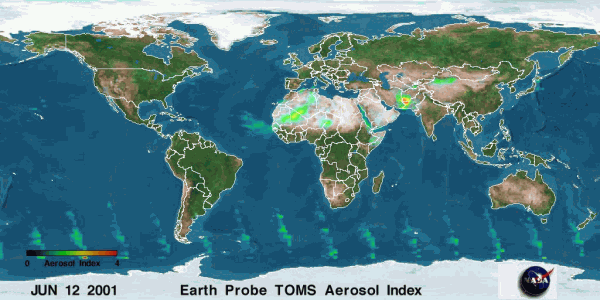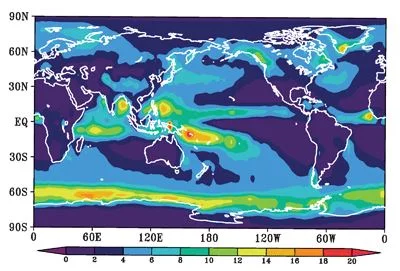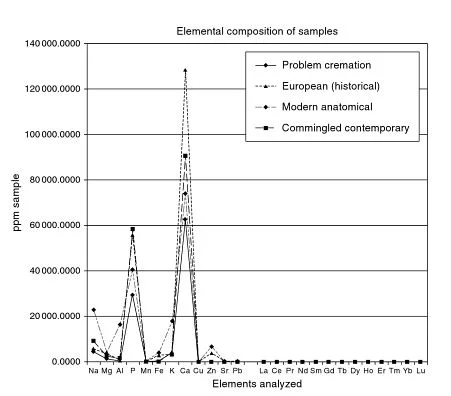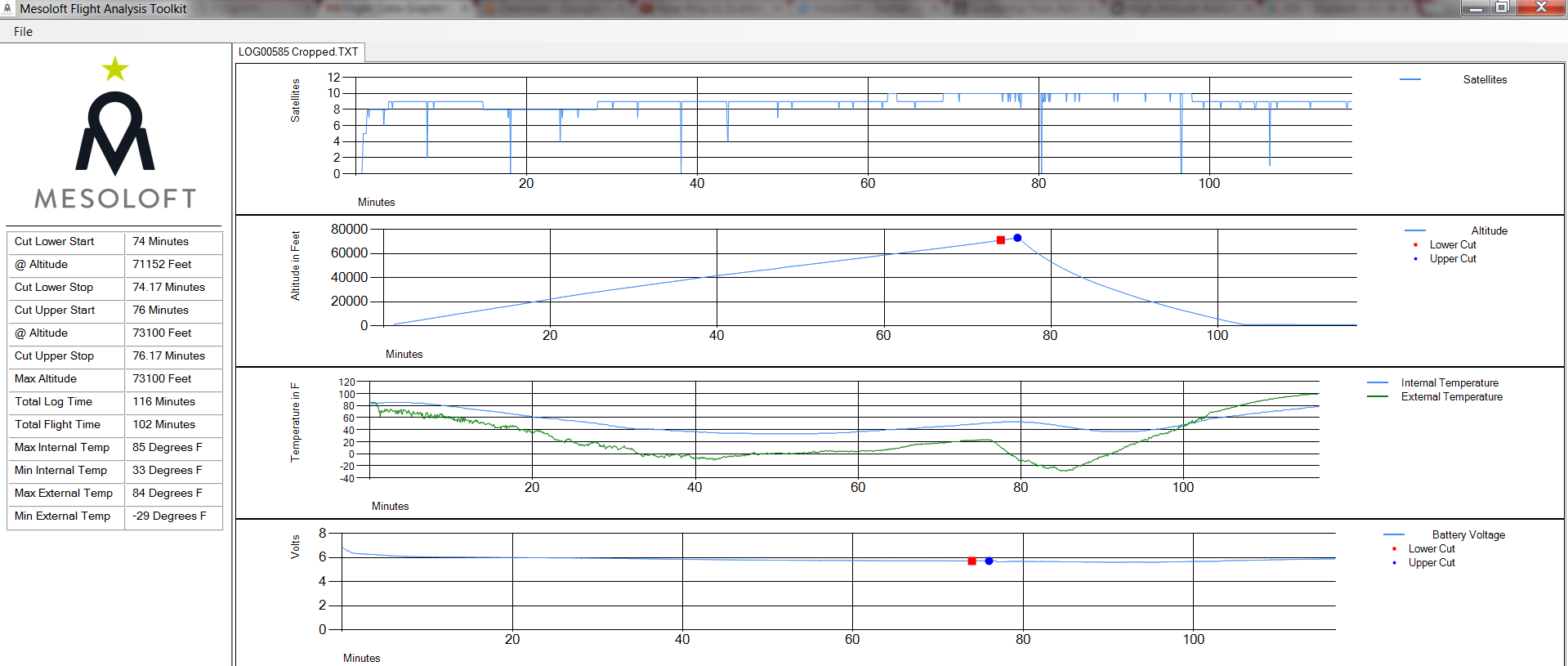Ash Dispersion
Earth's atmosphere suspends millions of tons of dust and ash from many sources: volcanic eruptions, forest fires, sandstorms, and meteoric impacts just to name a few. These solid particles are in a constant state of flux--traveling on atmospheric rivers from areas of higher concentrations to areas of lower concentration. There is no way to determine how long the cremated remains we disperse may stay airborne, but the study of other dust particles sheds insight on the question.
The image to the right from a NASA satellite called the Total Ozone Mapping Spectrometer (TOMS, for short). It shows the dispersal of sand from a large sandstorm in the Sahara Desert in June of 2001. In the 9-day window depicted below the Saharan sand plume traveled from West Africa, across the Atlantic to Florida. Note that a significant portion of the plume is still traveling at the end of the 9 day window.
Estimates put the total mass of sand, traveling from Africa to The Americas, as high as 56 million tons a year. The average particle size for the dust pictured above is about 10 microns--comparable in volume and density to the finer particles in cremated remains [4].
Cosmic dust, resulting from meteor impacts and their subsequent ablation, accounts for a significant amount of solids suspended in the upper atmosphere. There is still a high degree of uncertainty on the amount, but a 2012 article by the University of Leeds estimates the input per day at 100 - 300 tons [3]. Studies have shown that the cosmic particles can remain suspended for months. It is also worth noting that the deposition of these cosmic particles is not uniform on Earth's surface--the figure below shows much higher accumulations in the Southern Pacific and the Antarctic Shelf [3].
Annual averaged flux of Meteoric Particles to Earth's surface (predicted) (University of Leeds)
“During the months which MSPs spend in the mesosphere and upper stratosphere, the particles are likely to grow by agglomerative coagulation, which can be very rapid because of the long-range magnetic dipole forces between the Fe-containing particles.85 Models predict that the particles could grow to around 40 nm in radius by the time they reach the middle stratosphere around 30 km.”
interactive winds tool
Click the image below for a real-time model of winds in each layer of Earth's atmosphere.
Safety and Environmental Impact
Dilution
Ashes deployed by Mesoloft are dropped at a minimum altitude of 80,000 ft (over 15 miles). The average mass is approximately 2.0 lbs.
After deployment the ashes are a granular flow through a fluid (air), and they are dispersed according to the shearing forces caused by drag, balanced against the inertia of each grain and a negligible amount of cohesion in the ash cloud. The closest analogue that most of us can picture is a very tall but low-volume waterfall: laminar flow over the edge of the waterfall "wants" to stay together largely because of the cohesive nature of water (due to surface tension). As the water accelerates towards its terminal velocity, shearing forces due to drag increase to the point where the droplets separate--often to the point where the once-laminar flow is a fine mist by the time it hits the ground. These same forces act on our granular flow, but with far less cohesion and a much higher fall. So the ashes spread on the way down--even if there were no lateral winds to drive them apart.
Assuming a 5 degree spread angle on the cone of ash, the ground coverage would be calculated as follows (again, neglecting the 100 MPH winds in the ash's trajectory).
The typical mass of a grain of sand is 0.67 mg, so assuming the same density approximately 10 square meters would receive a single, invisible grain of sand.
Chemical Analysis of Human Cremains - Schmidt & Symes
CHEMICAL MAKEUP
The purpose of the cremation process is to destroy any organic material through an extended period at approximately 1800 degrees Fahrenheit. After the process, all that remains is inorganic material largely composed of Calcium Phosphate--which is the main inorganic constituent of bone--along with other essential elements (Mg, Na, Zn, and Fe). The elemental composition of cremated ashes almost perfectly mirrors that of bones [2].
Calcium Phosphate is found many places in nature. It is the chemical form of calcium found in cow's milk. It is also a common ingredient in fertilizers.
The Near-Space Experience
As the vehicle ascends through the troposphere, the outside temperature drops to as low as -60C. Near the top of the troposphere, it encounters the Jetstream, where winds regularly exceed 100 MPH. Above this is a thin band of atmosphere that forms the boundary between the Troposphere and the Stratosphere, The Tropopause. The Tropopause is the "ceiling" of Earth's weather.
The stratosphere is the next layer of atmosphere, and it contains the Ozone layer. Because of the presence of Ozone--which is highly absorbent of UV light--the ambient temperature begins to increase to nearly 0C.
At this point in the journey, Earth's atmosphere gives way to the blackness of space. The vehicle is above 99% of the molecules that make up our air. The air is perfectly silent and still, and looking down you can see the blue halo that is created by Hydrogen in Earth's atmosphere [1].
Mesoloft Vehicle Near 100,000 ft
Test Flight Data
Bibliography:
1. Wikipedia Page for Atmosphere of the Earth: http://en.wikipedia.org/wiki/Atmosphere_of_Earth
2. The Analysis of Burned Human Remains, Christopher W. Schmidt & Steven A. Symes:
3. Cosmic Dust in the Earth's Atmosphere, John M. C. Plane, School of Chemistry, University of Leeds, 8 April 2012, Royal Society of Chemistry: http://pubs.rsc.org/en/content/articlehtml/2012/cs/c2cs35132c#cit21
4. Lorraine Remer Tracks Dust from Outer Space, Jorge Salazar, EarthSky.org: http://earthsky.org/earth/loraine-remer-tracks-airborne-dust-from-outer-space
5. Tracking the long-distance travels of dust, Arthur Hirsch, The Baltimore Sun, 12 April 2013








